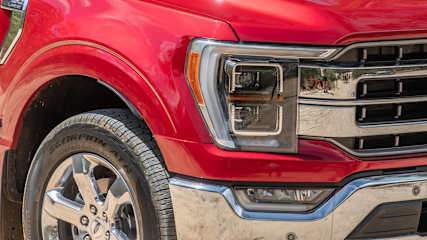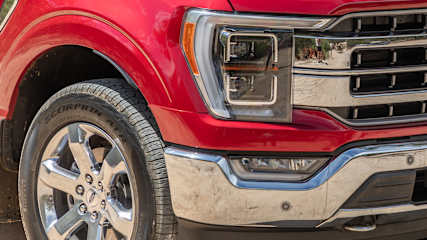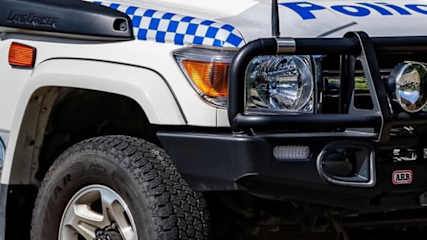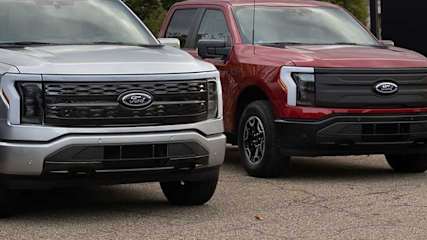Ford F150 News
_0.jpg)
No more Fords of this type anymore
Read the article
By Jack Quick · 16 Dec 2025
Ford has rejigged its electric vehicle (EV) strategy as it moves to prioritise hybrid technology for its larger models.
.jpg)
Fire safety scare for Ford Ranger
Read the article
By Tim Gibson · 11 Dec 2025
Ford has been hit with another recall notice, this time on some of its most popular variants.

Ranger Super Duty won’t end F-150, yet
Read the article
By Tom White · 01 Dec 2025
Ford's F150 is on struggle street despite an ambitious launch, but will the Ranger Super Duty be the final nail in its coffin?

Big US ute's Aussie nightmare almost over
Read the article
By Dom Tripolone · 28 Nov 2025
Ford’s F-150 experiment in Australia has hit lots of bumps along the road.Sales of the big rig have slowed to a trickle, with just four deliveries recorded in the past four months. A far cry from the 200-plus a month that were finding homes at the start of this year.This has been due to a hold on deliveries from as far back as July for what is believed to be a fix for quality issues.Good news, the long pause is over and the supply of F-150s will start to flow again once recall fixes have been undertaken.In that time it has ceded a lot of ground to its competitors.Ford has fallen well behind its rivals with just 549 F-150 sales through the first 10 months of this year. Ram has sold 2321 1500s in that time, Chevrolet has sold 1814 Silverado 1500s and Toyota 676 Tundras.The big American pick-up truck launched in 2023, but has been hit with numerous stop sale orders due to compliance issues and multiple recalls, which raises quality concerns.Ford Australia gave the contract to Thai-based company RMA Automotive to convert the F-150 from left-hand drive to right-hand drive in a Melbourne factory.The Blue Oval’s main rivals the Ram 1500, Chevrolet Silverado and Toyota Tundra are all converted by Walkinshaw, the company previously known for delivering fast Holdens. Remanufacturing vehicles from left- to right-hand drive is a big and complicated operation. The F-150 alone uses about 500 new parts and takes about 22 hours to convert.Ford has also just launched the Ranger Super Duty, which fills the role of the F-150 in many situations.It matches the F-150’s 4500kg braked towing capacity and has a superior GVM (4500kg) and GCM (8000kg).It is also cheaper and smaller, making it more palatable for Australian roads and car buying public.The Super Duty also uses diesel grunt compared to the F-150’s petrol power. The Super Duty uses a 154kW and 600Nm 3.0-litre turbo diesel V6 engine and the F-150 is powered by a 3.5-litre turbo-petrol V6 (298kW/678Nm).Ford’s Australian CEO Andrew Birkic recently told CarsGuide the F-150 was going nowhere.“I would see and the full-size pick-up segment as two different customers,” he said.“I think the full-size pick-up will continue to do well because it has a particular customer.”

Monster US pick-up truck in trouble
Read the article
By Dom Tripolone · 26 Nov 2025
Ford has issued another recall for its F-150 US-style pick-up truck.
.jpg)
ANCAP rips in on US pick-up truck safety
Read the article
By James Cleary · 07 Nov 2025
ANCAP turns gaze to big American pick-ups on Australian roads.
.jpg)
Monster upgrade for supersized ute
Read the article
By Tim Gibson · 23 Oct 2025
A top-end ute has received a major set of upgrades. The price and specifications for Ford’s 2026 F-150 range have been revealed. There are three variants, all in dual-cab form, with the base XLT starting from $114,950, which is an $8,000 jump from the previous model.There is some good news on the price front, with buyers now able to choose from short or long wheelbase options without additional cost. It keeps its 3.5-litre six-cylinder twin turbo-petrol engine that produces 298kW and 678Nm, with a 10-speed auto transmission. The XLT gets a part-time four-wheel drive system, while the two more expensive variants get a full 4WD set-up. There is plenty of new kit available on the base XLT, receiving several standout cosmetic additions such as chrome door handles and an exhaust extension. It also gets a 12-inch touchscreen and 12-inch digital drivers display as standard. The F-150 will battle Chevrolet’s Silverado and the RAM range for market share, with the two brands combining for more than 80 per cent of Aussie large dual-cab sales.All F150s are imported to Australia and then re-manufactured to right-hand drive in a Victorian RMA Automotive factory.Deliveries will commence in early 2026.The XLT grade comes as standard with20-inch alloy wheelsChrome door handles12-inch touchscreen12-inch digital drivers displayChrome exhaust extensionCloth seats12V port in load box Lariat adds20-inch chrome-like alloy wheelsPower tailgate14-speaker sound systemWireless phone chargerHeated and cooled front seatsRear heated seatsLeather accented seatsTwin panel sunroofExtended chrome side stepsRain-sensing wipersPower and heated mirrorsPlatinum adds20-inch painted gloss alloy wheelsBlack Ford badgingSmokes colour exhaust tip extensionAuto side stepsMulti-folding tonneau coverMassaging seats2026 Ford F-150 safetyThe Ford F-150 has not been crash tested. Safety features on XLT grade: Auto emergency breakingReverse brake assistRear parking sensorsPost-impact brakingBlind spot monitoringTrailer backup assist360-degree camera Lariat addsAdaptive cruise controlEvasive steer assistIntersection assistFront parking sensorsPlatinum addsRear cargo view cameraFord offers a five-year/unlimited km warranty on its vehicles.
.jpg)
No place in Australia for electric utes such as the Ford F-150 Lightning, Tesla Cybertruck, Chevrolet Silverado EV and others | Opinion
Read the article
By Stephen Ottley · 27 Sep 2025
Is the electric ute running out of charge already? Ram’s recent decision to scrap plans for an electric-powered version of its popular 1500 pickup may prove to be a turning point for the broader ute community.

Top five current police cars you never saw coming from the Ford F-150 to Toyota LandCruiser 70 Series
Read the article
By Laura Berry · 14 Jun 2025
Kia has just made a surprise confirmation that its new Tasman ute is currently being evaluated by police forces around Australia, and that had us thinking: what police vehicles are out there that aren’t the usual suspects?That's right, we're not talking police versions of the Kia Sorento, nor the Hyundai Tucson, or the Volkswagen Passat and Tiguan. We mean the left-of-field police cars. The ones you really might not have known were out there on the roads.So, with a little bit of help from Australian Police Vehicles Facebook group, here are our top five favourite police cars you might not have seen coming. Hyundai’s big eight-seater SUV is doing some undercover work for Victoria Police. This one spotted recently by Issacc Brown from IB Emergency Photography in the regional Victorian town of Sale happens to be the Calligraphy Black Ink edition of the Palisade. Exclusive to the Calligraphy Black Ink edition are 20-inch black glossy alloy wheels, tough looking dark-tinted radiator grille and black suede seats inside. The Palisade comes with two drivetrains and all-wheel drive which is powered by a 2.2 liter 4 cylinder turbo diesel or a front-wheel drive variant which uses a 3.8-litre V6 petrol. Oooh! NSW Police has got themselves a Chevrolet Suburban RST and this one spotted and snapped by Clinton J Down Photography is serving with the Tactical Operations Unit TOU. The RST grade means the large SUV comes with a 5.3-litre petrol V8, air suspension, 22-inch alloy wheels and luxurious interior features.The TOU role is “the safe resolution of high risk situations without loss of life, injury to persons or damage to property.”While this unmarked SUV is doing its best not to be noticed it’s hard not to miss something so enormous and rare on our roads.The Northern Territory Police are using an unmarked Ford F-150 as seen here snapped by an anonymous poster to the Australian Police Vehicles Facebook.While this full-sized American pickup truck is so large it almost blocks out the sun, it’s looking pretty inconspicuous as a police vehicle. The giveaways that this F-150 is serving on the force are the tiny LED emergency lights integrated subtly into the grille. You’d never know… well, almost.From what we can see this looks like the XLT grade which comes with a 3.5-litre V6 twin-turbo petrol engine and part-time four-wheel drive.Here’s one Kia kept quiet - Tasmania’s police has a Carnival people mover on its force as seen here in a photo taken by Taliesan Sharman.We’re big fans of the Carnival at CarsGuide with it not only being practical but great to drive making it the perfect big family car. This one seen here looks like just another suburban family hauler especially with the roof box and awning, but on closer inspection you’ll see emergency LED lights integrated into the grille and radio aerials. There have been some tough looking police vehicles, but not many can claim to being as tough as a Police Rescue Squad Toyota LandCruiser 70 Series as snapped here by Fleet Street Photography.This is a 2019 70 Series, which sports a 4.5-litre diesel V8 and was only available with a five-speed manual gear box. While more uncomfortable to pilot than a camel, if you did happen to have got yourself into an accident somewhere incredibly remote the chances of one of these vehicles making it to you and getting you out of there is 100 per cent.






